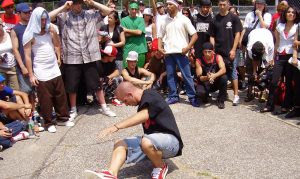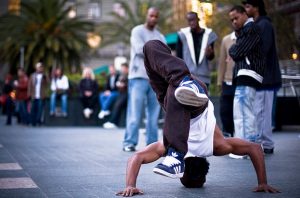The Hip-Hop movement began on the East Coast of New York City; however, it was not isolated to this location. Other street dances emerged on the West Coast in California.

Breaking, also called breakdance by the media, is the original street dance associated with Hip-Hop. This dance form is generally performed as a solo and is highly improvisational, emphasizing the dancer’s style and flair. Breaking consists of four primary components: toprocking, downrocking, power moves, and freezes.
Toprock refers to the movement that is performed from a standing position. Toprock highlights quick, percussive footwork paired with a relaxed upper body. Breakers generally begin with toprock to enter the cipher, a circle formation of people, where individual breakers take turns dancing.
Downrock or weight-bearing movement performed on the floor, where the dancers support their body with their hands and feet.
Watch This
The 6-Step, a basic footskill sequence used in breaking.
Power moves are physically demanding acrobatic moves borrowed from gymnastics and martial arts requiring strength and endurance, such as spins, floats, slides, and windmills.
Watch This
Floorwork and power moves were popularized by the Latinx community.
Freeze or a held position consists of the breaker halting the body from movement to achieve a challenging body pose, such as a headstand.

Don “Campbellock” Campbell created a funk dance style called locking. Locking consists of briefly freezing movement into a held position before continuing. Locking is highly performative, using comedic mine-like actions by using large and exaggerated gestures. Dancers interact with the audience by giving high fives and performing acrobatic moves like knee splits.
In the early 1970s, Campbell founded a group of dancers called the “The Campbellock Dancers,” later shortening the name to the “Lockers.” The Lockers received wide attention as they performed on several television shows, including The Tonight Show, The Carol Burnett Show, and Soul Train. Locking as a dance style has been featured in films, music videos, and hip-hop competitions.
Watch This
Don Campbell explain the creation of Locking.
Sam “Boogaloo Sam” Solomon created two dance styles, called boogaloo and popping. Boogaloo is an improvisational street dance that uses a fluid upper body movement to give the illusion of the body not having bones. Popping is a funk dance style involving contracting and releasing the muscles to cause a jerking effect. These actions produce a robotic-like quality. Movements associated with popping include waving, ticking, strobing, scarecrow, and tutting.
Solomon formed the dance crew the Electric Boogaloos and made television appearances on Soul Train that further popularized the dance style.
Watch This
Electric Boogaloos perform on Soul Train.